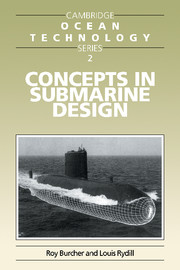Book contents
- Frontmatter
- Contents
- Introduction
- Acknowledgements
- 1 Design in general
- 2 Milestones in submarine history
- 3 Submarine hydrostatics
- 4 The weight/space relationship
- 5 Submarine structures
- 6 Powering of submarines
- 7 Geometric form and arrangements
- 8 Dynamics and control
- 9 Submarine systems
- 10 Considerations of building and costs in design
- 11 Generating a concept design
- Appendix 1 Hydrostatic conditions of flotation
- Appendix 2 Operational practice for keeping in trim
- Appendix 3 Assessing weight and size of variable ballast
- Appendix 4 Submarine pressure hull strength (Prediction of interframe collapse pressures)
- Appendix 5 Estimates of resistance and propulsion
- References and suggested reading
- Index
Appendix 2 - Operational practice for keeping in trim
Published online by Cambridge University Press: 05 July 2014
- Frontmatter
- Contents
- Introduction
- Acknowledgements
- 1 Design in general
- 2 Milestones in submarine history
- 3 Submarine hydrostatics
- 4 The weight/space relationship
- 5 Submarine structures
- 6 Powering of submarines
- 7 Geometric form and arrangements
- 8 Dynamics and control
- 9 Submarine systems
- 10 Considerations of building and costs in design
- 11 Generating a concept design
- Appendix 1 Hydrostatic conditions of flotation
- Appendix 2 Operational practice for keeping in trim
- Appendix 3 Assessing weight and size of variable ballast
- Appendix 4 Submarine pressure hull strength (Prediction of interframe collapse pressures)
- Appendix 5 Estimates of resistance and propulsion
- References and suggested reading
- Index
Summary
CATCHING A TRIM
The process of accurately adjusting the state of a submarine to neutral buoyancy and longitudinal balance is termed ‘catching a trim’. This is an important operation which is carried out when a submarine first dives when going on patrol, having left harbour and started passage on the surface. It provides a datum state for the submarine from which subsequent changes in weight or buoyancy can be easily compensated for, and enabling subsequent checks on trim made regularly during the patrol to be soundly based. The importance of keeping in trim is heightened should a submarine be required to remain quiet for any length of time because the process of catching a trim involves running pumps and so tends to be noisy.
It is desirable that when the submarine first dives at the start of a patrol it should not be grossly out of trim, and this requires that a good approximation to being in trim should be achieved before diving. The first step towards that end should have been taken when the submarine returned to harbour from its previous patrol, because it ought then to have been in good trim. From then on all changes in weight, e.g. due to re-storing, are carefully recorded and adjustments made to the contents of the Trim and Compensation (T & C) Tanks in order to correct for them. A methodical way often used for the purpose is by means of a ‘trim crib’, which has been previously drawn up for the submarine and gives the change in amount of water in the T & C Tanks appropriate to each weight change expected to be made during storing.
- Type
- Chapter
- Information
- Concepts in Submarine Design , pp. 279 - 281Publisher: Cambridge University PressPrint publication year: 1994



